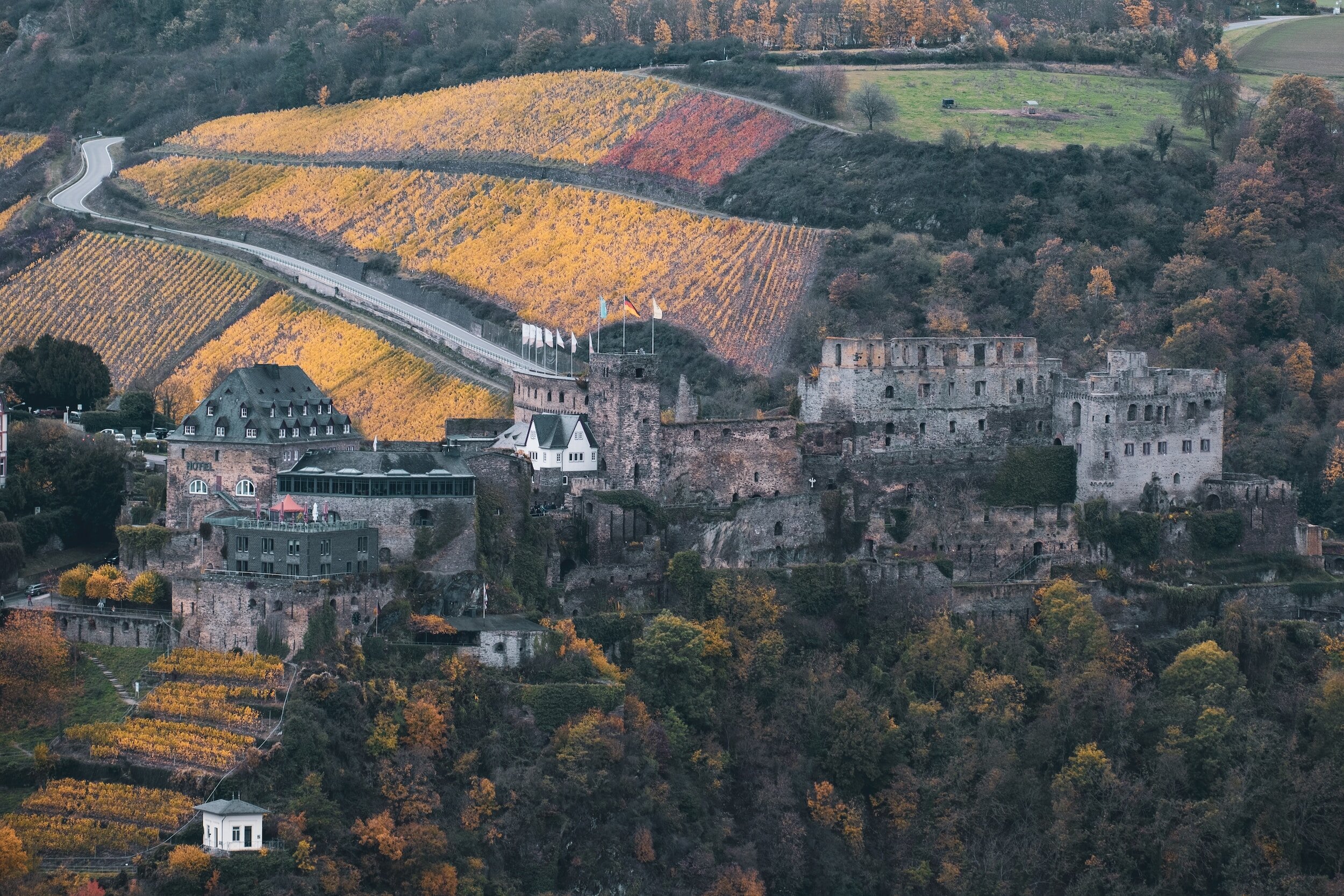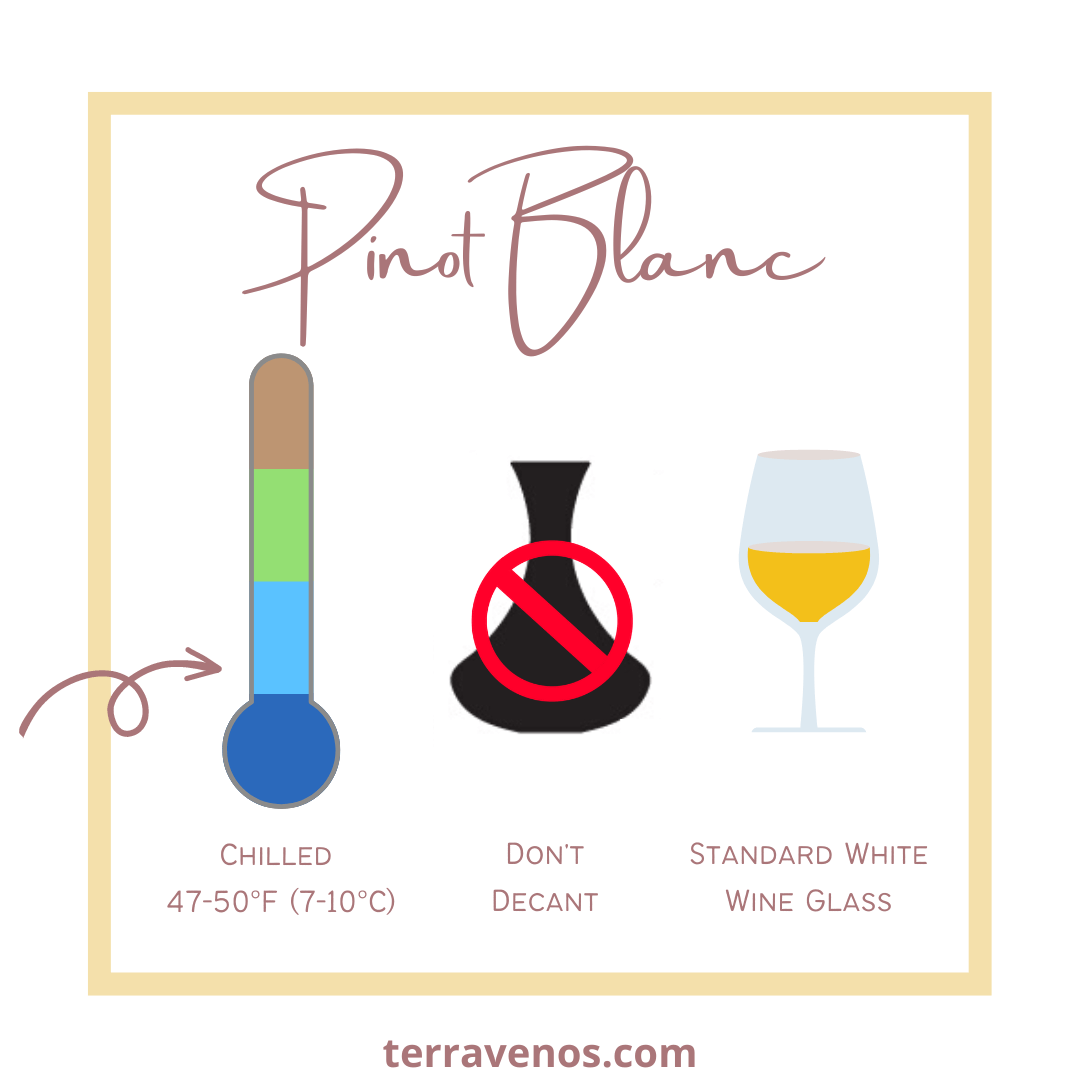
Pronunciation: PEE-noh BLAHNK
Pinot Blanc, a white wine varietal, finds itself at home in various wine regions. Whether you’re a wine enthusiast or a curious beginner, this comprehensive guide introduces you to Pinot Blanc.
TL;DR: If you like Chardonnay, you’ll probably enjoy Pinot Blanc.
- What Kind of Wine Is Pinot Blanc?
- Where Does Pinot Blanc Wine Come From?
- What Does Pinot Blanc Smell Like?
- What Does Pinot Blanc Taste Like?
- How to Serve Pinot Blanc Wine
- Pinot Blanc Food Pairing Suggestions
- Pinot Blanc vs. Pinot Grigio: The Differences
- Pinot Blanc in the Vineyard
- Notable Pinot Blanc Producers and Bottles to Try
- Emerging Trends and Innovations
- Final Thoughts – Pinot Blanc as a Must-Try White Wine Varietal
What Kind of Wine Is Pinot Blanc?
Pinot Blanc is a medium-bodied white wine with medium acidity, a moderate alcohol level, and a smooth character. It often falls between Chardonnay and Pinot Grigio in terms of style.
Fun Wine Fact: For many years, it was thought that Pinot Blanc and Chardonnay were one and the same. Pinot Blanc tends to have a fuller body, further adding to the confusion.
Where Does Pinot Blanc Wine Come From?
Pinot Blanc, a grape variety originating from the Alsace region in France, is grown in several wine regions around the world. Depending on the specific region, Pinot Blanc can be either a standalone varietal or used in blends. In France, Alsace is known for producing exceptional Pinot Blanc wines.
Pinot Blanc in Alsace
In Alsace, Pinot Blanc is one of the main white grape varieties, alongside Riesling, Gewürztraminer, and Muscat. The region’s cool climate and diverse terroir contribute to the production of high-volume and high-quality Pinot Blanc wines that showcase its unique characteristics.
Unhelpful Wine Fact: If you see Pinot Blanc on a bottle of wine from Alsace AOC, it doesn’t mean it’s made from the Pinot Blanc grape. It could be made from a number of different grapes, including: Pinot Noir, Pinot Gris, Axerrois Blanc, or Pinot Blanc. Ahh, the vagaries of wine regulations.
Play with the map above. You can see the Vosges Mountains to the left (West) of Alsace, protecting the vineyards from Atlantic storms and creating a rain shadow perfect for making fine wines.
Pinot Blanc in Other Regions

Pinot Blanc has also found its way into other wine regions. It is cultivated in countries such as Germany, Italy, Austria, Canada’s Okanagan, and the United States. In Italy, for example, Pinot Blanc is known as Pinot Bianco and is used to produce crisp and refreshing white wines.
Helpful Wine Buying Tip: If you see a white wine labeled as Pinot Blanc, Pinot Bianco, or Weißburgunder (Weissburgunder), it’s most likely Pinot Blanc.
What Does Pinot Blanc Smell Like?

Pinot Blanc exhibits a delicate aroma profile with subtle floral notes and hints of white fruits such as apple and pear. It can also display a touch of minerality, and a hint of almond, adding to its overall complexity. Unlike its aromatic cousin, Pinot Gris, Pinot Blanc has a more restrained fragrance.
Fun Wine Fact: Did you know that Pinot Blanc is a genetic mutation of Pinot Noir? They share a close relationship and are part of the Pinot family of grapes. Pinot Noir has one of the highest rates of natural mutation.
What Does Pinot Blanc Taste Like?

Pinot Blanc offers a range of flavors depending on the region and winemaking techniques. It typically showcases crisp acidity, along with flavors of green apple, citrus, stone fruits, and sometimes almond. In some instances, Pinot Blanc can display a slightly creamy texture, enhancing its overall mouthfeel.
On the palate, Pinot Blanc delivers a refreshing and well-balanced experience.
Compared to Pinot Grigio, Pinot Blanc tends to have a more rounded and nuanced flavor profile.
Helpful Pinot Blanc Wine Buying Tip: Pinot Blanc is often treated like Chardonnay in the winery. You can have fuller-bodied Pinot Blanc wines that were aged in oak and lighter, more acidic Pinot Blancs aged in stainless steel. Read the tasting notes and bottle labels before you buy your Pinot Blanc to find a wine you’ll enjoy.
I always think that Pinot Blanc offers a delightful balance between freshness and complexity, making it a versatile white wine for various occasions.
Is Pinot Blanc a Heavy Wine?
Pinot Blanc is generally a medium-bodied white wine. It can exhibit both light and fuller-bodied styles depending on the winemaking approach and the specific region. However, most Pinot Blanc wines lean towards a lighter to medium body, offering an elegant and easy-drinking experience.
Is Pinot Blanc Dry or Sweet?
Pinot Blanc is most often a dry white wine, though it can be made in off-dry styles. If you see Pinot Blanc with lower alcohol levels (under 11% ABV), it may be off-dry. Look for label clues.
Helpful Tip: Here’s how to figure out if a wine is sweet before you buy it.
How to Serve Pinot Blanc Wine

Temperature
Serve Pinot Blanc slightly chilled, around 45-50°F (7-10°C). This temperature range allows the wine’s aromas and flavors to shine while maintaining its refreshing qualities.
Glassware
Opt for a white wine glass with a slightly narrow rim to concentrate the delicate aromas. The glass should have a moderate bowl size to allow the wine to breathe and develop its full potential.
Decanting
Pinot Blanc typically doesn’t require decanting. However, if you have a more complex and mature Pinot Blanc, a brief decanting of 10-15 minutes can help enhance its aromatic expression.
Aging Potential
Most Pinot Blanc wines are meant to be enjoyed while young and fresh, within the first 2-3 years of release. However, certain high-quality and barrel-aged Pinot Blancs can develop more complexity and age gracefully for up to 5-7 years.
Pinot Blanc Food Pairing Suggestions

Pinot Blanc’s versatile nature, with its medium-bodied character, makes it an ideal companion for a variety of dishes. Enhance the wine’s delicate flavors and balanced acidity by pairing it with roasted white meats.
The subtle herbal notes and refreshing qualities of Pinot Blanc also complement grilled vegetables, such as zucchini, corn, or sweet red peppers. For a creamy and flavorful option, try pairing Pinot Blanc with a mushroom risotto featuring asiago cheese.
Quick Tips: Pinot Blanc Food Pairing
- Roasted chicken or pork with a herb rub
- Grilled zucchini, corn, or sweet red peppers
- Creamy mushroom risotto with asiago cheese
Pinot Blanc vs. Pinot Grigio: The Differences
| Category | Pinot Blanc | Pinot Grigio |
|---|---|---|
| Acidity | Medium | Crisp |
| Body | Medium-bodied | Light-bodied |
| Flavors | Green apple, citrus, stone fruits | Citrus, orchard fruits |
| Oak Aging | Some examples may have oak influences | Rarely aged in oak, emphasis on freshness |
| Mouthfeel | Rounded, nuanced | Crisp, refreshing |
| Notable Regions | Alsace (France), Italy, Germany, USA | Italy, France (Alsace), USA (California), Germany |
| Food Pairing | Roasted white meats, grilled vegetables, creamy mushroom risotto | Light seafood, salads, vegetarian dishes |
While Pinot Blanc and Pinot Grigio share a common genetic background, they have distinct characteristics that set them apart. Pinot Blanc tends to have a more rounded and nuanced flavor profile, with a touch of creaminess and complexity.
In contrast, Pinot Grigio is often lighter, crisper, and more focused on bright citrus and orchard fruit flavors. Both wines offer their own unique charm, catering to different preferences.
Discover More:
Pinot Grigio vs Pinot Blanc
Pinot Grigio vs Albarino
Chenin Blanc vs. Sauvignon Blanc
Pinot Grigio vs Vermentino
Sauvignon Blanc vs Pinot Grigio
Pinot Blanc in the Vineyard
Today, winegrowers have a better understanding of how cultivation in the vineyard influences Pinot Blanc wines. High-yielding vineyards produce wines of lower intensity, suitable for everyday wines. Vineyards that limit yields tend to produce Pinot Blanc wines of intense flavor and aromas.
Unfortunately, Pinot Blanc doesn’t have the same reputation for fine wines as Riesling, for example, and will often be planted in less-suitable sites. If you find a producer that specializes in Pinot Blanc wines, it’s worth trying!
Fun Wine Fact: Pinot Blanc is known by various names and synonyms, including Pinot Bianco (Italy) and Weissburgunder (Germany).
Notable Pinot Blanc Producers and Bottles to Try
When exploring Pinot Blanc, seek out producers known for their expertise and dedication to crafting exceptional bottles. Some notable wineries include:
- Trimbach (Alsace, France)
- Jermann (Friuli-Venezia Giulia, Italy)
- Zind-Humbrecht (Alsace, France)
- Robert Weil (Rheingau, Germany)
These wineries offer a range of Pinot Blanc wines, each showcasing their unique regional characteristics and winemaking styles.
Fun Wine Fact: Pinot Blanc can be crafted into sparkling wines, and is the main white grape used in Cremant d’Alsace. Look for this in specialty wine shops.
Check out this great domain overview of Zind-Humbrecht:

Emerging Trends and Innovations
The world of wine is constantly evolving, and Pinot Blanc is no exception. Winemakers are exploring new techniques and styles, pushing the boundaries of tradition. From skin-contact Pinot Blanc to amphora aging, these innovations contribute to the ongoing evolution of Pinot Blanc and offer new dimensions to its expression.
Final Thoughts – Pinot Blanc as a Must-Try White Wine Varietal
With its delicate flavors, refreshing acidity, and versatility, Pinot Blanc deserves a place among the must-try white wine varietals. Here are three key takeaways to remember:
- Distinctive Flavor Profile: Pinot Blanc showcases flavors of green apple, citrus, and stone fruits, with a touch of creaminess and complexity.
- Food-Friendly: Pinot Blanc pairs well with a variety of dishes, including roasted white meats, grilled vegetables, and creamy mushroom risotto.
- Regional Diversity and Enjoyment: Pinot Blanc displays regional diversity, allowing wine enthusiasts to explore different expressions from various wine regions.
Thirsty for More?
It’s going to happen sooner or later, but how do you know when your white wine is bad? Check it out.
Love exploring white wines? Here are a few more notable dry white wine varieties to try.
If you’re planning a wine tasting, check out this list of food pairings that complement white wines.




